News Archive 2015
2015-12-22
Merry Christmas and a Happy New Year!
The pre-Christmas vibrations are getting stronger and preparations for the big day are in full swing. Earthquakes are unfortunately still not quite predictable, but we will keep our seismic ears open in 2016.
We wish you happy holidays and all the best in the new year!
Swiss Seismological Service
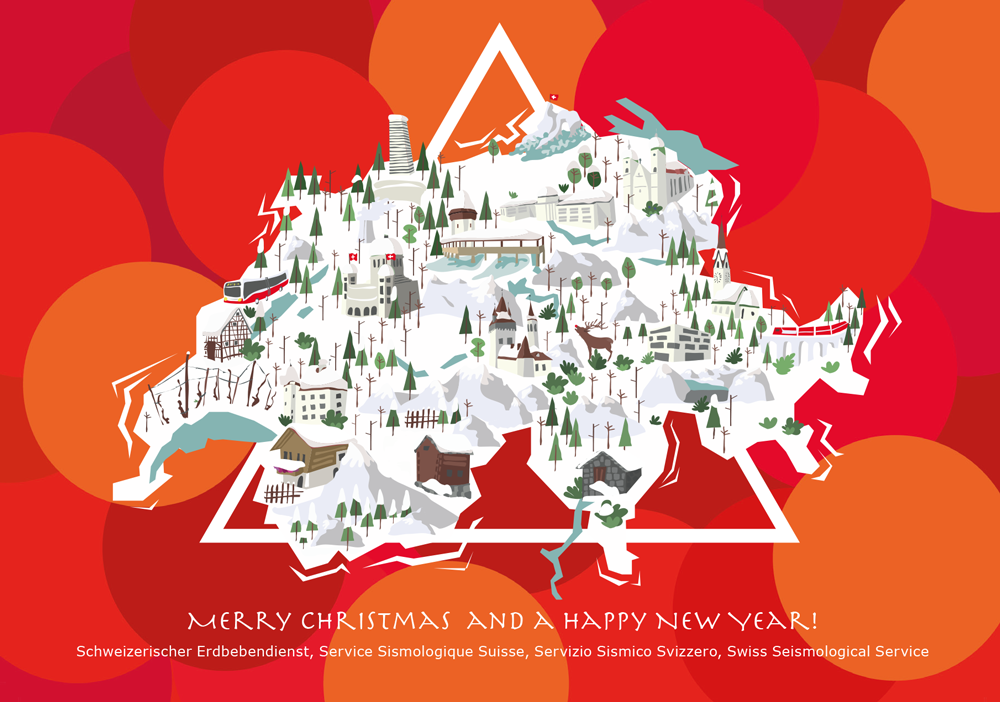
2015-12-22
Strong Motion Portal (SSMP)
The SED now provides a new portal dedicated to delivering event-based strong motion data from Swiss seismicity, available at strongmotionportal.seismo.ethz.ch. The SED strong-motion porta (SSMP)l provides access to peak ground motions and response spectra within minutes of any significant earthquake (ML > 2.5) being manually confirmed that occurs in the greater Swiss region. SSMP supports download of these waveforms through the SED ArcLink portal. All modern digital strong motion event data, with collection beginning in 1990, is now available through this service. Event detection and subsequent waveform processing are fully automated, with no human interaction.
The Strong Motion Portal is similar to the European-level RRSM portal at orfeus-eu.org/rrsm and was developed in cooperation with the ORFEUS Data Centre.
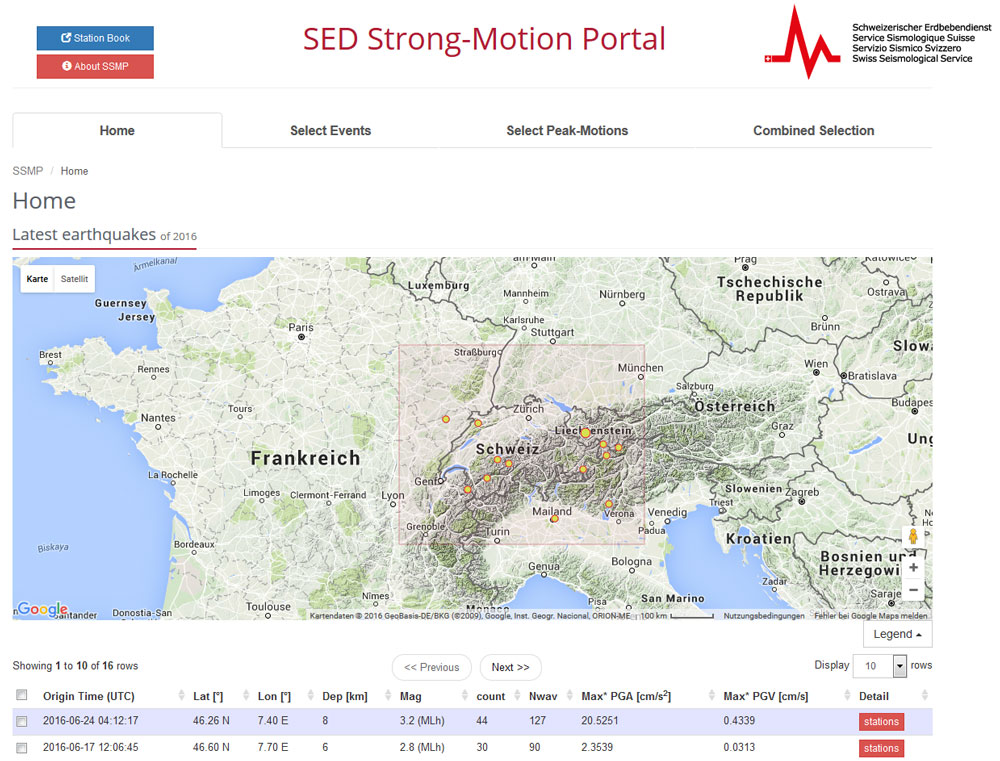
2015-12-03
Naturgefahrenportal des Bundes neu auf Romanisch
Das Naturgefahrenportal des Bundes für die Bevölkerung ist neu auch auf Romanisch verfügbar. Unter der Adresse www.privels-natira.ch stehen ab sofort Informationen zur Naturgefahrenlage in der vierten Landessprache zur Verfügung.
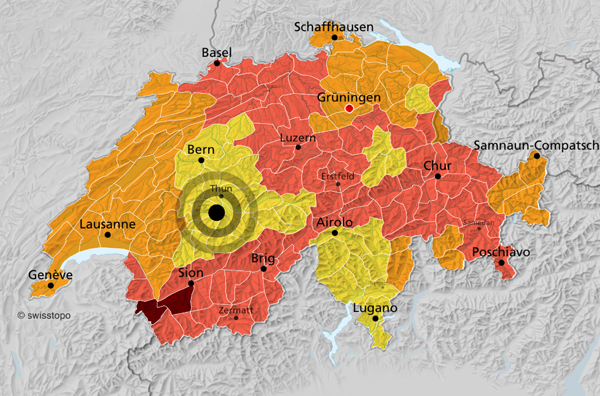
2015-11-19
Two active earthquake swarms in Valais
Since June of this year, two earthquake sequences have been active in Valais – largely unnoticed by the general population – in locations around 12 km apart. One is occurring approximately 5 km north-east of Sion, while the other is located about 6 km north of Sierre.
The earthquake swarm near Sion was preceded by a magnitude 3.0 earthquake on 20 June 2015. Although seismicity directly after the event was very limited, the SED has recorded an increase in seismic activity since the beginning of October. The majority of the recorded earthquakes occurred at a depth of around 8 km, most probably in the crystalline bedrock. A similar series of earthquakes was observed in 2011 approximately 2 km north-west of Sierre. The density of the SED’s seismic network, coupled with new methods of analysis, means that it is possible to observe even very small earthquakes with a magnitude of less than zero.
Read more...To the north of Sierre, the earthquake swarm increased in intensity toward the middle of October. During this period, the strongest of the swarm earthquakes measured thus far occurred, with a magnitude of 3.1 (10/14/2015). The second-strongest earthquake, with a magnitude of 2.7, was recorded on 11/18/2015. The earthquakes’ hypocenters were at a depth of approximately 4 km. A look at the history books shows that this area has experienced similar rates of activity in the past. In the summer of 1996, three earthquakes with a magnitude of 2.5 or greater took place.
In spite of the spatial and temporal proximity of the two swarms, there is currently no indication that they are directly linked. Furthermore, historic analyses show that such sequences are not unusual for Valais. Swarm activities generally end after a few weeks or months; in rare cases, the strength and number of the earthquakes increase over time.
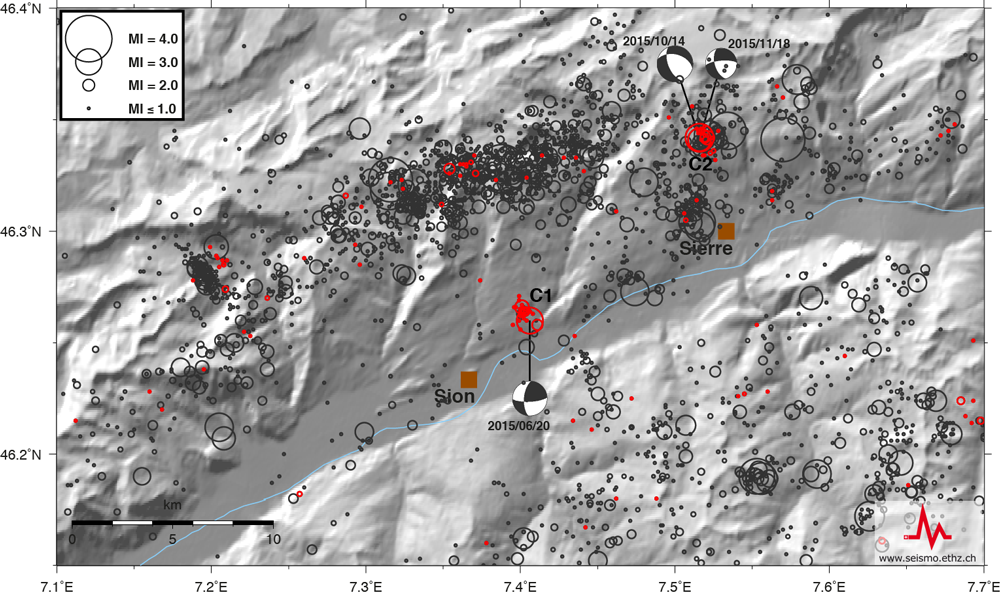
2015-10-26
All Natural Hazards at a Glance on One Government App
As of today, all natural hazard warnings and notifications issued by the Swiss Confederation will be available on the free MeteoSwiss App. It has been designed to complement the service provided by the natural hazards portal www.natural-hazards.ch. Notifications of potentially noticeable earthquakes are sent to the app automatically and displayed on the overview map. The app is available for iOS, Android, and Windows and can be downloaded from the respective stores.
Read more...In contrast to other natural hazards, advance warning of an earthquake is not possible. In principle, earthquakes can occur anytime and anywhere. The Swiss Seismological Service (SED) will publish on both the MeteoSwiss App and natural-hazards.ch the likely effects for each warning area of earthquakes with a magnitude of 2.5 or greater. Warning areas close to the location of the earthquake (epicenter) will be accorded a higher danger level than those further away. The danger levels refer to the intensity of the earthquake in a specific warning area. The intensity is a measure of the effects of an earthquake. In addition, some danger levels contain a rough estimate of the likelihood of aftershocks. You can find a detailed explanation of the danger levels here.
The automatically generated earthquake notifications will generally be available within a few minutes and serve primarily to immediately inform the population, media, and authorities of potentially noticeable earthquakes in Switzerland. The SED seismologists on duty check each of these notifications for accuracy after they have been sent out automatically and will, on rare occasions, make minor corrections. With an automatic system, there is unfortunately also the chance of false alarms. For this reason, earthquake notifications are displayed directly on the hazard map, but not sent as push notifications.
An overview of all available SED information channels in case of an event can be found under the heading Informed at Any Time.
MeteoSwiss App: Google Play – App Store – Windows Store

2015-10-26
Starkes Erdbeben im Hindukusch (Grenzregion Afghanistan-Pakistan)
Am Montag, 26. Oktober 2015 hat um 09:09 Uhr (UTC) ein Erdbeben der Stärke 7.5 Afghanistan und Pakistan erschüttert. Der Ausgangspunkt des Bebens lag in den Hindukusch Bergen in einer Tiefe von etwa 200 km.
Read more...Kabul und Islamabad wurden stark erschüttert, das Beben war zudem in bis zu 1000 km entfernten Städten deutlich spürbar. Dazu gehören Dehli in Indien, Lahore in Pakistan, Taschkent in Usbekistan oder Dushanbe in Tadschikistan. Schäden werden vor allem in den Berggebieten bei verletzbaren Gebäude erwartet zudem ist mit zahlreichen Erdrutschungen zu rechnen.
Ähnliche Ereignisse (Lage, Tiefe und Magnitude) ereigneten sich schon 1921, 1949, 1965, 1983, 1985 und 2002, das heisst, alle 20 Jahren im Durchschnitt.
Das genaue Schadensausmass ist noch nicht bekannt, es sind aber bereits über hundert Todesopfer alleine in Pakistan zu beklagen. Im Jahr 2002 haben beim letzten grösseren Beben 150 Leute ihr Leben verloren. Für das Beben vom 26. Oktober ist von schwerwiegenderen Konsequenzen auszugehen. Unter anderem, weil die betroffenen Gebiete politisch unstabil und für die Rettungskräfte schwierig zu erreichen sind.
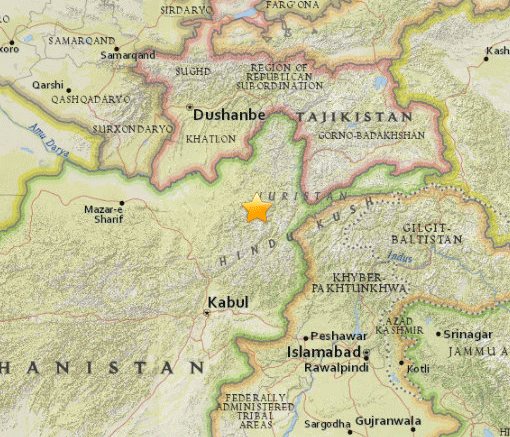
2015-09-04
Recurrence of Earthquake Swarm near Diemtigen (BE)
Earthquake swarms are a typical feature of earthquake activity in Switzerland, and the Swiss Seismological Service (SED) registers several of them every year. These sequences of earthquakes are characterized by the fact that they cannot clearly be classified into a series of foreshocks, a main shock, and aftershocks. The earthquakes in a swarm, the numbers of which can vary from just a few to several thousand events, occur over a short period of time and in a small geographical area, and can last from a few hours to several years. As earthquake swarms outside Switzerland often occur in volcanically active regions with magmatic and hydrothermal activity, the theory is that they are related to the movement of fluids (gases and liquids) in the earth’s crust.
Read more...One of the most active earthquake swarms the SED has recorded since it was first founded is currently occurring near Diemtigen in the Bernese Oberland. More than 144 events with a magnitude of 0.5 or greater were recorded between April and December 2014. The three strongest earthquakes in this period occurred on May 10 (magnitude 2.7), on June 25 (magnitude 2.7), and on October 15 (magnitude 3.2). Since January 2015, swarm activity has decreased substantially and disappeared almost entirely in the summer months, before becoming more intense again in mid-July. Since then, the SED has registered 21 earthquakes with a magnitude of 0.5 or greater; the strongest with a magnitude of 2.7 occurred on August 15.
In order to investigate the “Diemtigen swarm” in more detail, the SED set up three mobile seismological stations in the region between June 2014 and April 2015. An initial analysis shows that the earthquakes have occurred in a steeply inclined zone extending to 400 by 700 meters at a depth of approximately 9 kilometers. Further, a complex shift pattern of seismic activity along this zone was observed. Thanks to a highly sensitive procedure, earthquakes with a magnitude of as little as –1.5 were detected. Thus, over 2,300 microearthquakes could be registered between January 2014 and September 2015, providing a very detailed picture of the swarm activity (see Figure 1).
Another increase of earthquake activity after a period of rest is nothing unusual, but does not allow any conclusions regarding how the swarm will progress. Swarm activities usually end after a few weeks or months; in rare cases, the strength and number of the earthquakes increase over time.
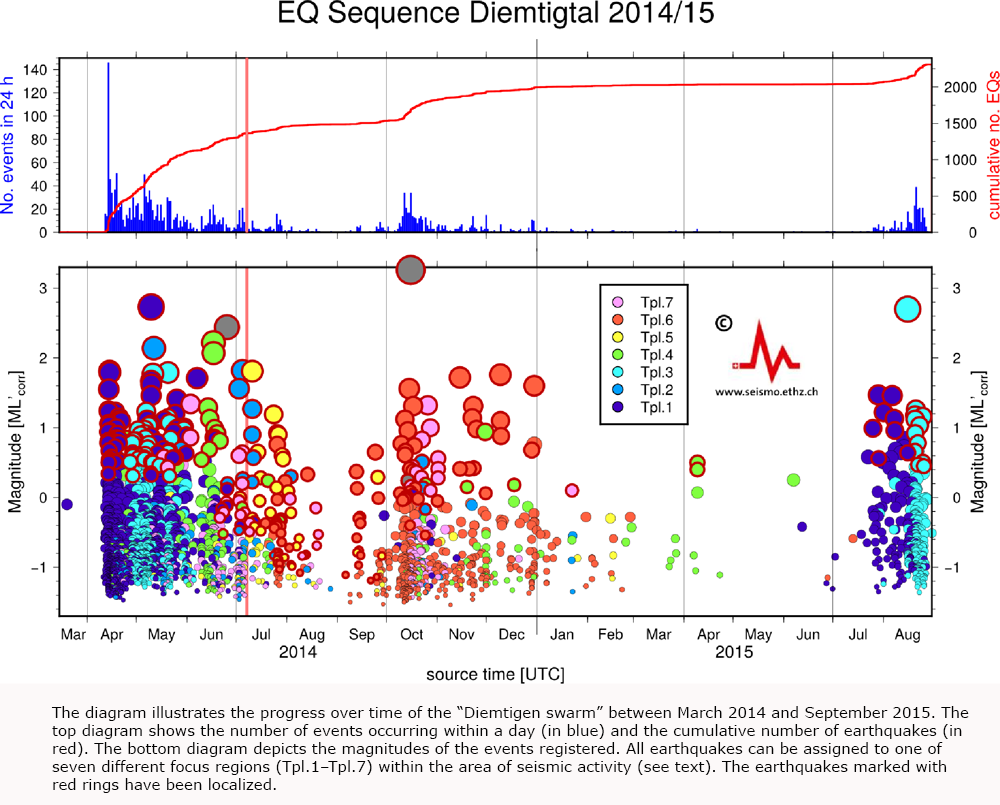
2015-09-01
Earthquakes – A Serious Hazard for Switzerland
After ten years of intensive research, the Swiss Seismological Service (SED) at ETH Zurich has created an updated seismic hazard model, which confirms that earthquakes are a serious hazard for Switzerland.
Estimates suggest that in Switzerland earthquakes are the natural hazard with the greatest potential for causing damage. On behalf of the federal government, the SED monitors earthquake activity and estimates the level of seismic hazard in Switzerland. The SED regularly publishes a model describing possible future earthquakes and the associated ground movements. The newly-published, updated seismic hazard model is based on improved predictive models, new and more exact data, and revised estimates based on historical sources. It replaces the model from 2004 and facilitates a more concrete assessment of the level of hazard. Experts and authorities will use the new model as a basis for making decisions regarding earthquake mitigation and the risk management involved.
Read more...Overall, estimates of the hazard level in individual regions have changed only slightly since 2004. Valais remains the area with the highest level of hazard, followed by Basel, Graubünden, the St. Gallen Rhine Valley, and central Switzerland. According to the SED’s estimates, only the canton of Graubünden, and in particular the Engadine, has a higher level of hazard than previously assumed. This slightly higher hazard can be explained by a revised understanding of previous earthquakes in the region.
You can find further information on this site.
Professionals can find additional information, specific data, and parameters here.
We Want Your Opinion! Are you satisfied with the information about the updated seismic hazard? Click here for the questionnaire.
Flyer "Seismic Hazard Switzerland"
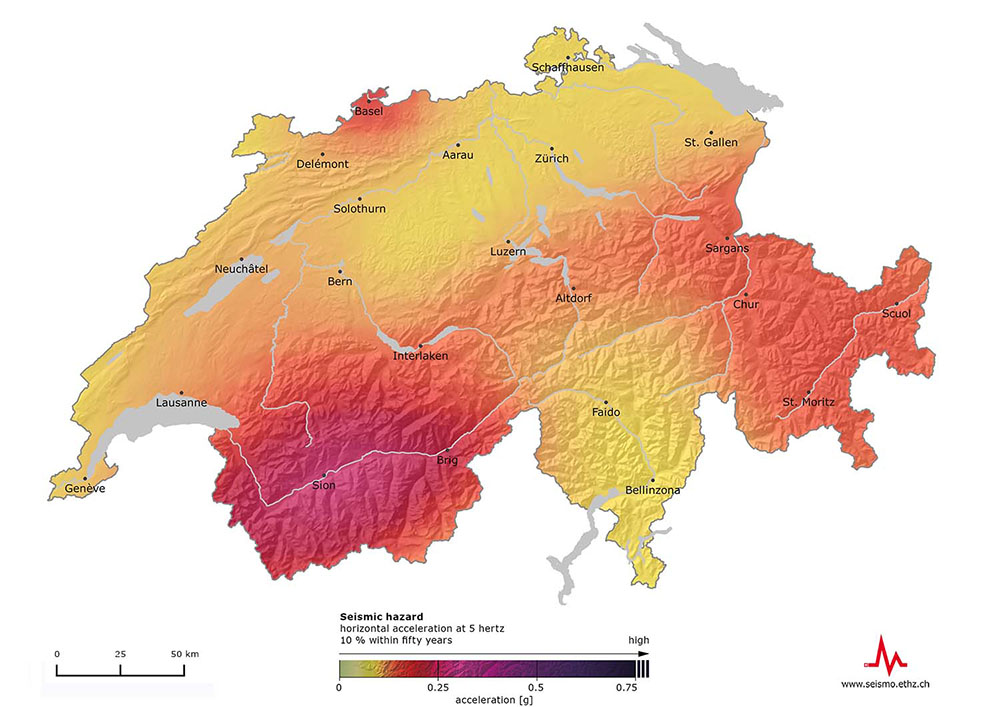
2015-08-11
Scientifica 2015: Mit Lichtgeschwindigkeit vor Erdbeben warnen?
Über elektromagnetische Wellen können gemessene Erdbebensignale bereits heute mit Lichtgeschwindigkeit übertragen werden. Der Schweizerische Erdbebendienst geht der Frage nach, wie Licht künftig noch besser dabei helfen kann, die Auswirkungen von Erdbeben einzudämmen.
Trotz vielfältigen Erkenntnisgewinnen bleibt in der Seismologie einiges im Halbdunkeln. Mit einer grossflächigen Projektion auf ein Relief der Schweiz, Informationen zu Erdbebenlichtern sowie Erläuterungen zur Erdbebenfrühwarnung bringen wir an der Scientifica etwas Licht ins Dunkle! Sie haben zudem Gelegenheit, Ihre Reaktionsfähigkeit nach dem Eintreffen eines Erdbebenalarms zu testen, mehr über das empfohlene Verhalten im Ereignisfall zu lernen sowie im Erdbebensimulator verschiedene Beben hautnah mitzuerleben.
Besuchen Sie uns im ETH Hauptgebäude! Die Scientifica findet am Wochenende vom 5. und 6. September 2015 statt.

2015-08-04
"Forschung live" mit dem SED
Die Akademie der Naturwissenschaften Schweiz (SCNAT) macht anlässlich ihres 200-jährigen Jubiläums Naturwissenschaften auf vielseitige Weise erlebbar. Unter dem Motto „Naturwissenschaften erlebbar nah“ koordiniert sie schweizweit diverse Veranstaltungen für Gross und Klein. Der Schweizerische Erdbebendienst (SED) beteiligt sich mit zwei Beiträgen an „Forschung live“:
Read more...12. August 2015, 19.30 bis 21.00 Uhr, Sozialarchiv Zürich
Remo Grolimund, Historiker beim SED, präsentiert das Buch „Die Naturforschenden“ mit einer multimedial begleiteten Lesung aus seinem Beitrag über den Schweizer Geophysiker und Grönlandforscher Alfred de Quervain.
14. August 2015, 18.15 bis 19.30 Uhr, ETH Zürich, Gebäude NO
Erfahren Sie im Vortrag „Erdbebenland Schweiz“ mehr über die Naturgefahr mit dem grössten Schadenspotential hierzulande und erleben Sie im Erdbebensimulator, wie sich ein Erdbeben anfühlt.

2015-07-29
Major Earthquake in Nepal: Three Months On
On April 25, 2015, an earthquake with a magnitude of 7.8 hit Nepal, causing massive, widespread damage. The Swiss Seismological Service has put together a fact sheet looking back on the last three months from a seismological point of view. It focuses on aftershock activity in the region as well as the question of future earthquakes and their possible consequences.
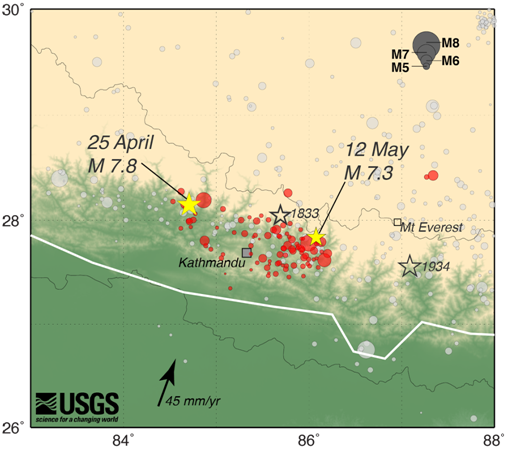
2015-06-30
The SED at Expo Milano 2015
The video "Water – the Source of Life" will be showing until August 2, 2015, in the Swiss pavilion at Expo Milano 2015. In the video, ETH Zurich presents researchers who explore fundamental questions associated with the topic of water. Claudia Röösli, a PhD student at the SED, is among them. Using seismometers, she examines icequakes from glaciers to find out more about the motion of the ice and to draw inferences about the consequences of climate change.
Watch the video "Water – the Source of Life" here (SED contribution from 2:12)

2015-06-20
Spürbares Erdbeben bei Sion (VS)
Am Samstag den 20. Juni 2015 um 12:30 Uhr (Lokalzeit) hat sich 5 km nordöstlich von Sion (VS) in einer Tiefe von 8.5 km ein Erdbeben mit der Magnitude von 3.0 ereignet. Das Epizentrum lag in der Gemeinde Ayent.
Die Erschütterungen waren vor allem in der Region zwischen Sion und Sierre für die Bevölkerung sehr gut spürbar. Das Rhonetal ist aufgrund seiner Bodenbeschaffenheit (weiche Sedimente) bekannt für die deutliche Verstärkung von Erdbebenwellen. Aus diesem Grund sind zahlreiche Verspürtmeldungen aus der Bevölkerung des Rhonetals auf der Internetseite des Erdbebendienstes eingegangen. Bei einem Erdbeben dieser Stärke sind jedoch keine Schäden zu erwarten.
Read more...Das Wallis und im Speziellen die Region nördlich von Sion/Sierre hat die höchste Erdbebenaktivität in der Schweiz. In diesem Gebiet ereignete sich 1946 das letzte grosse Erdbeben in der Schweiz. Mit einer Magnitude von 5.8 hat es zahlreiche Schäden an Gebäuden in den damals noch weniger dicht besiedelten Städten Sion und Sierre verursacht.
Das Epizentrum des Erdbebens vom 20. Juni 2015 lag etwas näher an Sion verglichen mit den Erdbeben, welche sich in den letzten Jahren in dieser Region ereignet hatten. Zum Beispiel erschütterten im Januar 2010 drei Beben mit einer Magnitude grösser als 3.0 Sierre und die nähere Umgebung und 2003 ereigneten sich zwei Erdbeben mit Magnitude 3.5 einige Kilometer weiter nördlich als das aktuelle Beben.
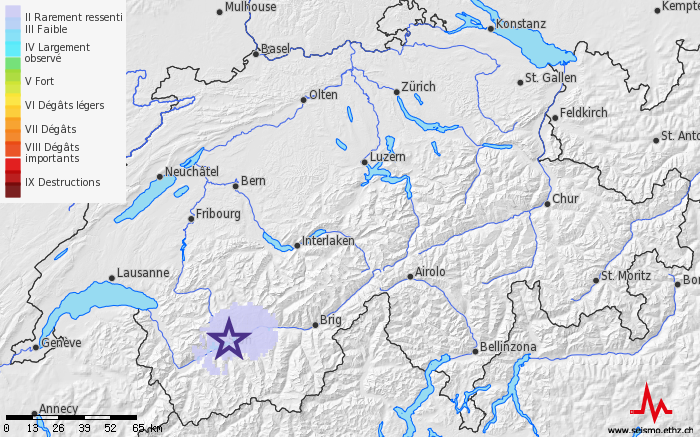
2015-06-15
Earthquake near Bourg-Saint-Pierre (VS)
Near Bourg-Saint-Pierre (VS), the Swiss Seismological Service registered an earthquake on June 15, 2015 at 05:14 (local time). The earthquake had a magnitude of 3.2 and occurred at a depth of 3 km. The earthquake was located close to the Italian border and has been felt by a few people in the lower Valais. The last felt event in this region was measured on November 23, 2014 near Vallorcine (F) with a magnitude of 3.2. In general, around 200 earthquakes are registered each year in the canton Valais with 72 possibly felt events in the last 15 years.
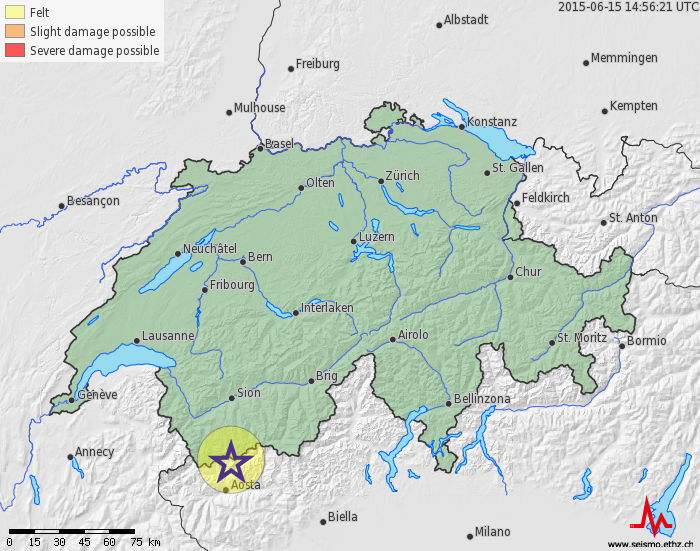
2015-05-12
Another Strong Earthquake in Nepal
Nepal was hit by another strong earthquake, with a magnitude of 7.3, on May 12, 2015, at 7.05 a.m. (UTC) (9.05 a.m. Swiss time, 12.50 p.m. local time). The epicenter lay 80 kilometers northeast of Kathmandu, close to Mount Everest on the Tibetan border, at a depth of around 15 kilometers. The earthquake originated on the same tectonic boundary between India and Asia as the earthquake of April 25, 2015, and at the same depth on the eastern end of the rupture. This is expected to have caused further damage east of Kathmandu, while strong aftershocks are also expected and a further major earthquake cannot be ruled out.
Further information is available on the USGS website.
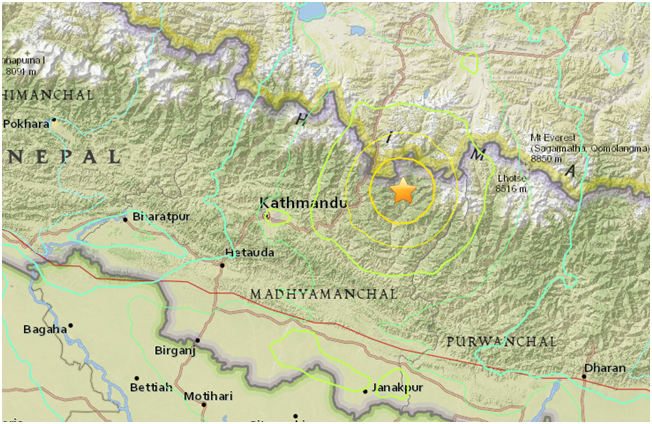
2015-05-04
First Place in Earth and Marine Sciences
ETH Zurich occupies the top spot for Earth & Marine Sciences in this year’s QS World University Rankings by Subject. The rankings are based on academic reputation, employer reputation and research impact. The Department of Earth Sciences, with which the Swiss Seismological Service is associated, triumphed against other participants to attain the top position for the first time, having reached ninth place last year. ETH Zurich has been placed 12th in the overall university rankings, maintaining its position from last year. The Swiss Seismological Service is very pleased with these excellent ratings and thanks ETH and D-ERDW for the fruitful cooperation!

2015-04-27
Strong Earthquake in Nepal
Nepal was shaken by an earthquake with a magnitude of 7.8 at 6.11 a.m. (UTC) on Saturday, April 25, 2015. The earthquake occurred approximately 80 kilometers northwest of the capital Kathmandu at a depth of 15 kilometers, and is one of the ten most powerful instrumental recorded in the Himalayas. The last similarly powerful earthquake to hit Nepal occurred over 80 years ago in 1934, with a magnitude of 8.2. The last large earthquake in this region struck Kashmir and Pakistan, with a magnitude of 7.6.
Read more...The Himalayan region has one of the highest levels of seismic activity in the world, and is an area in which large earthquakes often occur. The reason for this is the collision of the Indian and Eurasian Plates, with the Indian Plate moving toward the Eurasian Plate at a rate of almost five centimeters per year. A number of main and auxiliary faults run parallel to the plate edges in an east–west direction. It was along one of these faults that the earthquake on Saturday occurred. According to information gathered so far, the rupture surface covers an area measuring 150 kilometers to the southeast of the epicenter and around 50 kilometers in a north–south direction. The Nepalese capital Kathmandu was right above the rupture surface. To the west of the epicenter toward Pokhara the vibrations were not as strong.
By comparison, in the European Alps, where the Eurasian and African Plates collide, the rate of collision is only between one and four millimeters per year. The strongest earthquakes on record in the Alps registered a magnitude of 7 – around 20 times weaker than the earthquake with a magnitude of 7.8 that struck Nepal.
There have been a number of aftershocks since, some of which have been very strong. The strongest aftershock was approximately as powerful as the earthquake that struck Basel in 1356 – the strongest earthquake ever recorded in Switzerland. Further powerful aftershocks can be expected over the course of the coming weeks. These may cause more destruction, avalanches, and landslides. The aftershocks will continue for a period of months, and a further large earthquake cannot be ruled out completely.
The exact extent of the damage caused is still not known, but the earthquake has already claimed several thousand fatalities.
Additional information on the earthquake can be accessed via the following links:
Tagesschau news report from 26.04.2015 (in German)
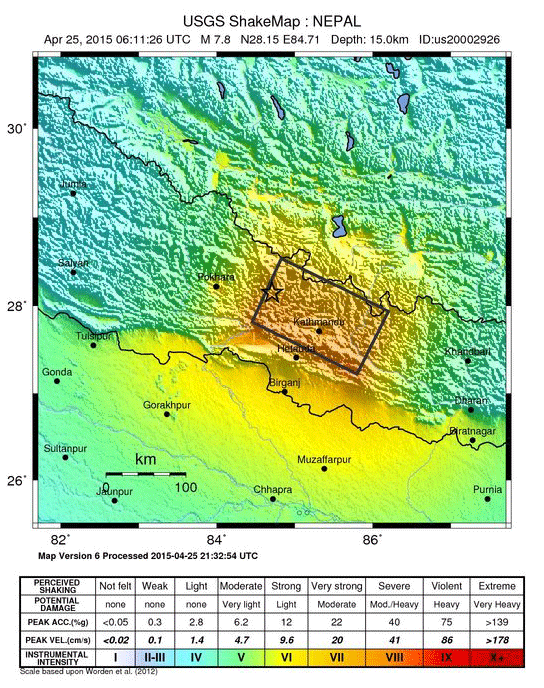
2015-04-06
Kleineres Beben bei Bern
Am Montag, 6. April 2015 ist um 15:18 Uhr (Lokalzeit) nahe der Stadt Bern ein Erdbeben registriert worden. Das Epizentrum lag ca. 10 km südlich der Berner Innenstadt. Das Beben hatte eine Stärke von 2.6 auf der Richterskala. Aufgrund der geringen Tiefe (ca. 6 km) ist das Beben verbreitet verspürt worden. Bei einem Erdbeben dieser Stärke sind in der Regel keine Schäden zu erwarten.
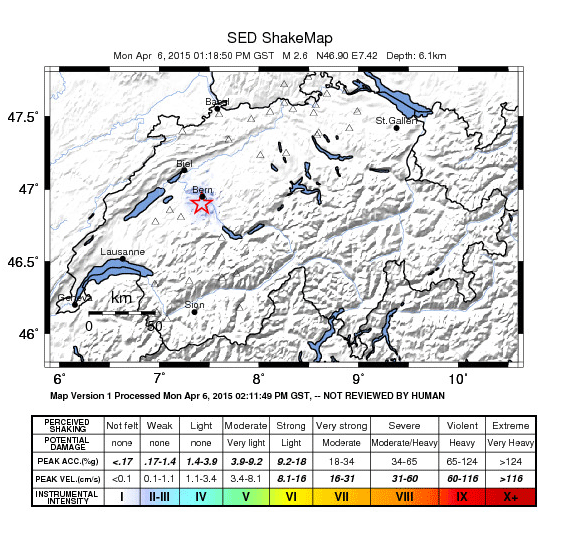
2015-03-19
Man-Made Earthquakes "Moved" the Schatzalp
From March 10 to March 13, 2015, more than 160 seismologists, geophysicists, engineers, geologists, and social scientists gathered in Davos for the first Schatzalp workshop on "Induced Seismicity". Man-made earthquakes are a controversial and highly pertinent issue with regard to geothermal energy production (in Switzerland, especially in Basel and St. Gallen), fracking, underground CO2 storage, and mining. Scientists from across the globe exchanged ideas and thoughts on the current state of research and potential implications for the future. The workshop was organized by the Swiss Seismological Service in collaboration with the Swiss Competence Centre on Supply of Electricity (SCCER-SoE), the Swiss Federal Office of Energy (SFOE), and the Research Forum Physics of the Earth (FKPE).
For further information about the workshop, visit the Schatzalp website here
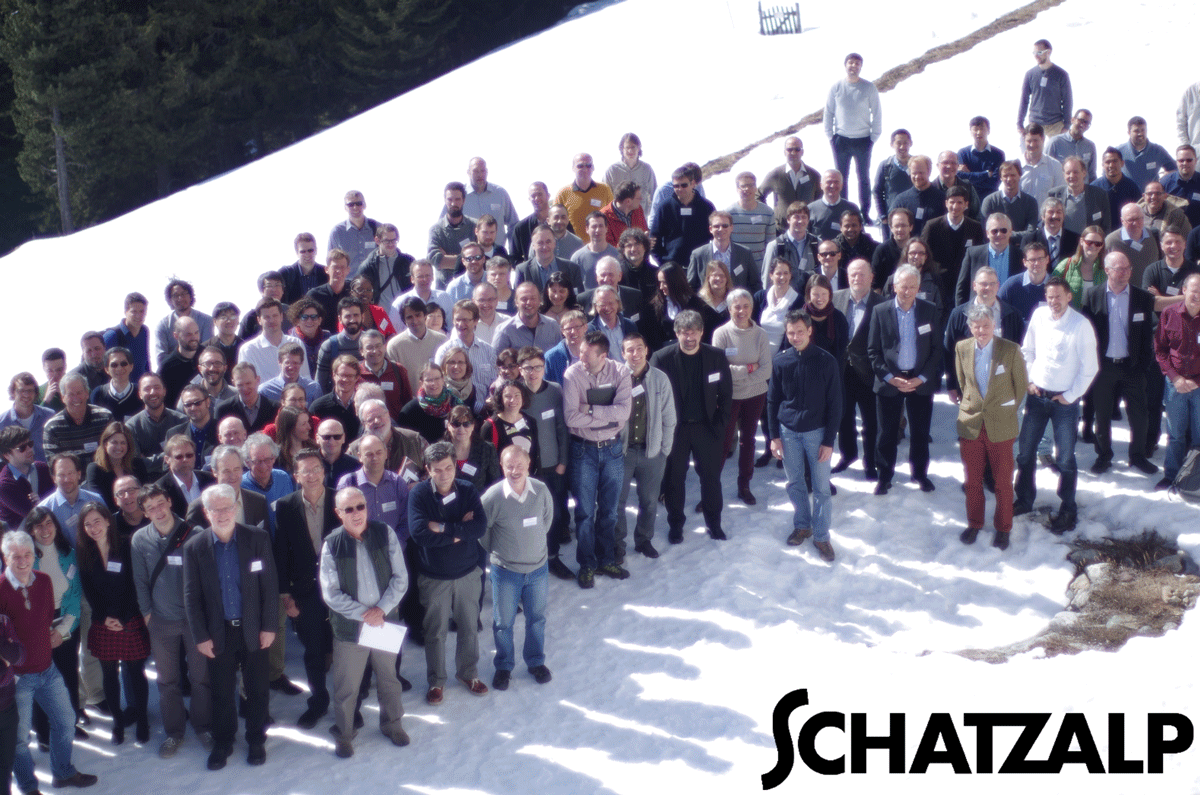
2015-03-16
Meteorite Leaves Seismic Traces
On March 15, 2015, at 8.45 p.m., seismic stations across the whole of Northeastern Switzerland picked up signals from a meteorite. The sound waves triggered by the meteorite were recorded over a four-minute period from Urnerland to Glarus and all the way to beyond Lake Constance. A station near Andermatt in the canton of Uri was the first to register the meteorite. The Seismological Service received seven reports from people who had heard rumbling sounds. With careful analysis, the seismic data can be used to constrain the path and landing site. The SED is collaborating with international experts in order to improve our understanding of the event. It seems likely meteoroid fragments landed in the Ticino.
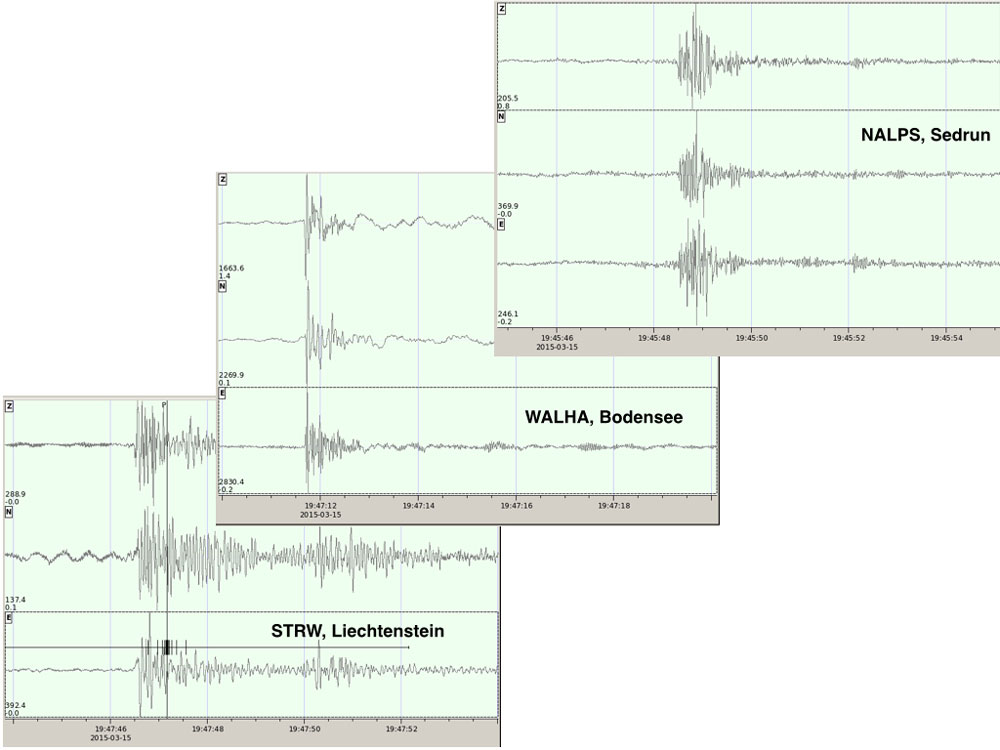
2015-03-12
Two New SNSF Professors
The Swiss National Science Foundation (SNSF) recently awarded 40 professorships to outstanding young researchers. Two Swiss Seismological Service (SED) employees, György Hetényi and Fabian Walter, received professorships worth around CHF 1.5 million each. Congratulations!
Read more...György Hetényi is moving to the University of Lausanne after four years at the SED. In his new post, he will focus on the 3-D study of structures and modeling of the processes that led to the formation of the Alps and the Himalayas. Fabian Walter, who has worked on various projects at the SED since 2010, will stay on at ETH Zurich. As part of his SNSF professorship, he will carry out research at the Laboratory of Hydraulics, Hydrology and Glaciology on how glacial ice avalanches and glacial lake outburst floods can be predicted using seismic data.
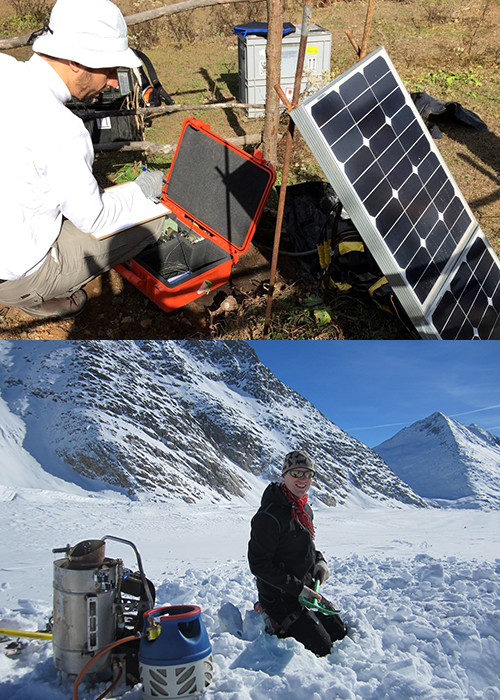
2015-03-05
Improved Access to Earthquake Data
The Swiss Seismological Service has improved how its data and event archives can be explored and accessed by professionals. The existing, openly accessible web portal at arclink.ethz.ch has been redesigned and is now more user-friendly. The portal supports interactive browsing of the station inventory, earthquake catalogue, and then download of either continuous or event-based waveform data. In addition we now also support web services from the International Federation of Digital Seismograph Networks (FDSN).
More information can be found here.
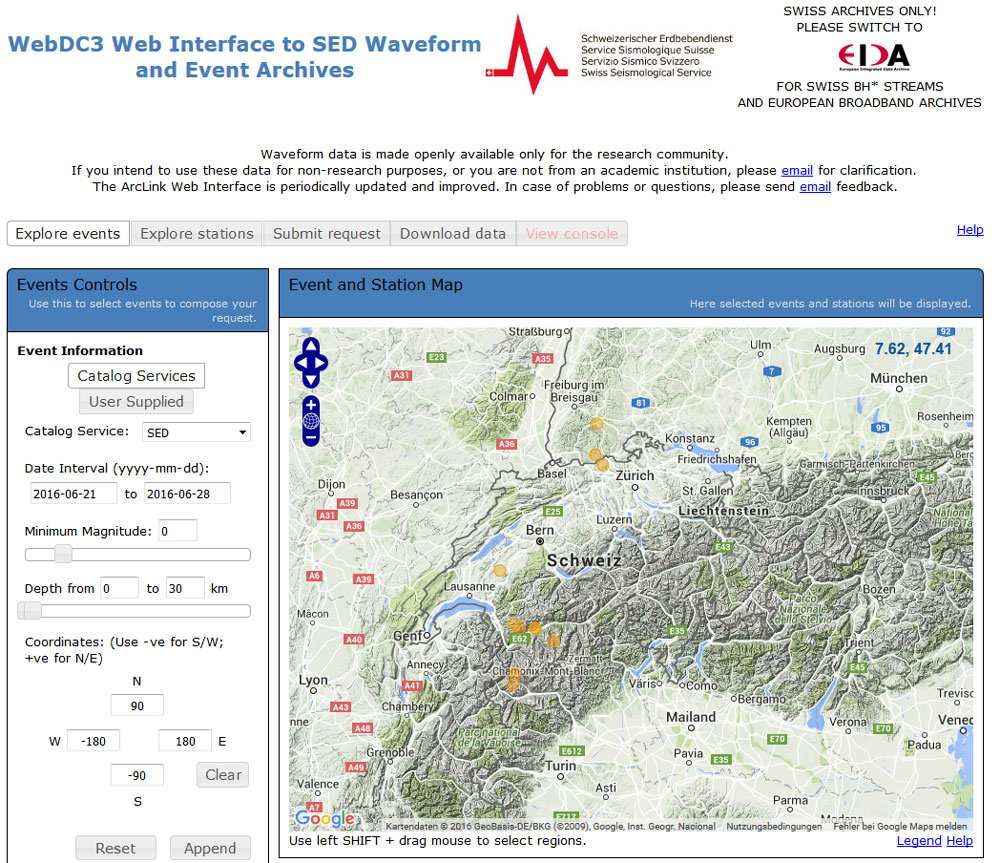
2015-02-26
Die Stadt der Zukunft: bitte erdbebensicher!
Die Bilder nach den Erdbeben in Haiti, Japan, L’Aquila oder Christchurch haben sich tief eingeprägt: zerstörte Häuser, chaotische Szenen, Verletzte und Tote. Erdbeben bleiben auch für die Städte der Zukunft eine tödliche Gefahr, aber wir sind ihnen nicht machtlos ausgeliefert.
Hier geht es zum ganzen Artikel im Zukunftsblog der ETH Zürich
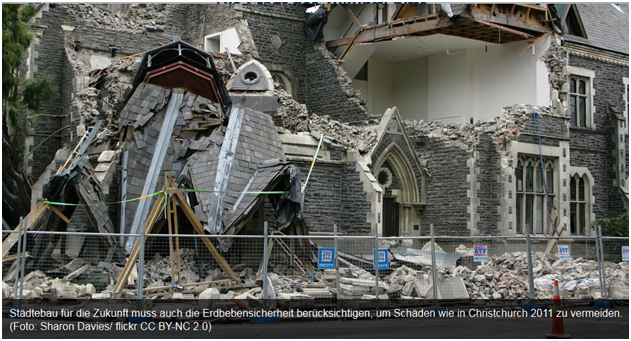
2015-02-04
Interview avec un sismologue du SED sur les séismes près de Bienne
"En trois jours, la région de Bienne et du Jura bernois a tremblé cinq fois. Aujourd’hui encore à 12h21. L’événement n’est pas nouveau, mais attire toute l’attention du Service Sismologique Suisse qui n’exclut pas une catastrophe dans les années à venir. Le spécialiste Clotaire Michel évoque même la possibilité d’un tsunami dans l’un de nos lacs, même si, pour l’instant, les séismes qui touchent notre région ne sont, pour la plupart, qu’imperceptibles!"
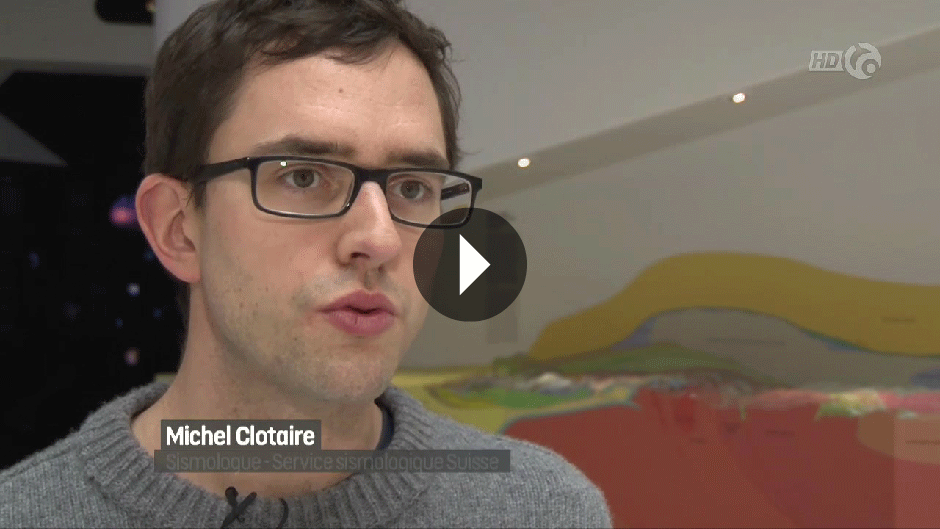
2015-02-03
When Will the Next Major Earthquake Occur?
For the Japanese subduction zone, the answer is “at any time", as researchers from the Swiss Seismological Service (SED) argue in their article in Nature Geoscience, which was published today.
Read more...The research project focused on the following question: How quickly after a large-scale earthquake can a second earthquake occur? In the process of trying to answer this question, SED researcher Dr. Thessa Tormann, together with her colleagues from the SED and Tsukuba University in Japan, used statistical methods to analyze data from nearly one million smaller earthquakes. All of these earthquakes were recorded in the Japanese subduction zone before and after the Tōhoku earthquake on March 11, 2011, which had a magnitude of 9. The results of the research show that the fault returned to its original stress levels in a surprisingly short period of time, which indicates that a second earthquake could occur relatively quickly after a massive earthquake of that scale. Luckily, earthquakes of that magnitude tend to occur only once every few centuries on average; however, the results from the SED researchers show that there is no period of safety after a major earthquake.
Here is a link to the article "Randomness of megathrust earthquakes implied by rapid stress recovery after the Japan earthquake" (the full article is behind a paywall).
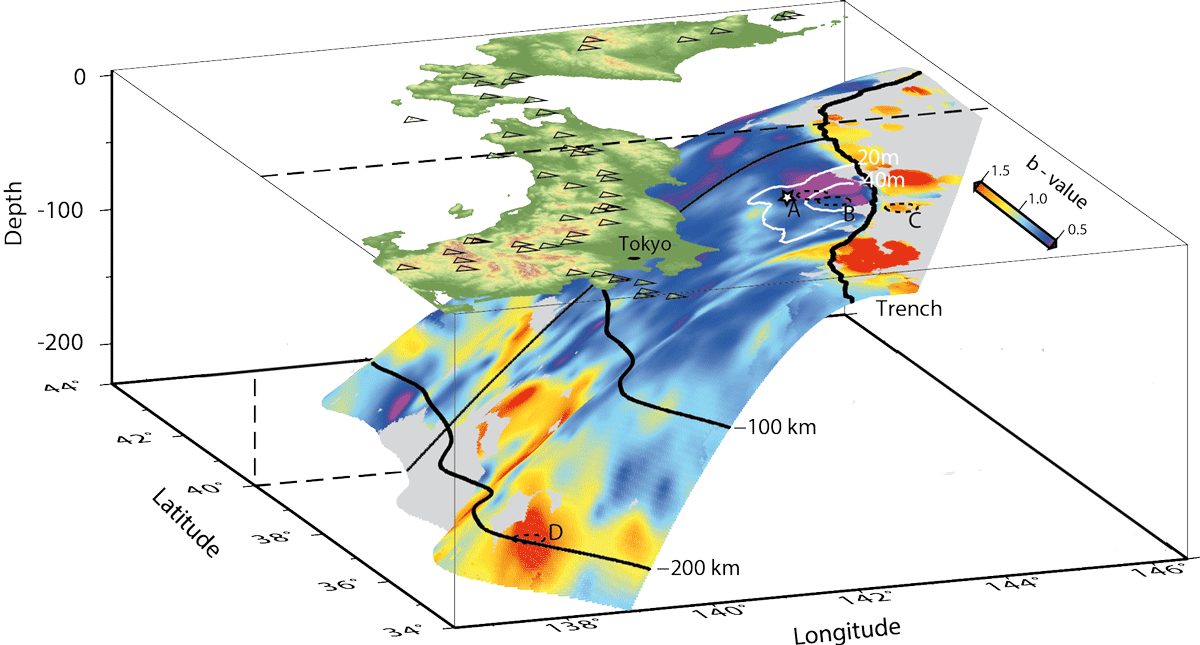
2015-02-02
Drei spürbare Beben bei Biel
Seit dem 31. Januar 2015 haben sich bei Biel mehrere kleine Erdbeben ereignet. Davon sind drei von der Bevölkerung verspürt worden. Am stärksten wahrgenommen wurde das Beben vom 31. Januar um 22:54 Uhr mit einer Magnitude von 3.1, wie aus über 300 Verspürtmeldungen hervorgeht. Vor allem rund um den Bielersee sowie im südlichen Jura wurde das Beben deutlich wahrgenommen. Wenige Personen meldeten zudem, das Beben vom 31. Januar um 23:20 Uhr (M = 2.0) verspürt zu haben sowie jenes vom Montagmorgen, 2. Februar um 05:05 Uhr (M = 2.6). Schäden sind bei Erdbeben dieser Stärke nicht zu erwarten.
Read more...Die letzten spürbaren Beben bei Biel mit Magnituden von 2.7 und 3.2 ereigneten sich am 8. Januar 2014. Bis zum 30. Januar 2014 registrierten die Messgeräte des SED über 25 Nachbeben. Mit Magnituden zwischen 0.6 und 2.2 waren sie aber zu schwach, um von vielen Personen verspürt zu werden. Eine solche Häufung von kleineren Nachbeben stellt in der Umgebung von Biel nichts Aussergewöhnliches dar. Ein Blick in die nähere Vergangenheit verrät, dass sich bei Saint-Ursanne, Solothurn oder Fribourg ähnliche Sequenzen ereignet haben. Sie richteten allesamt keine Schäden an.
Auch dieses Jahr haben sich bereits einige Nachbeben bei Biel ereignet, die für die Bevölkerung nicht spürbar waren. Solche Erdbebensequenzen klingen in der Regel von selbst wieder ab, in seltenen Fällen entwickeln sie sich zu einem länger anhaltenden Erdbebenschwarm oder nehmen gar mit der Zeit in Stärke und Anzahl zu. Die Entwicklung eines Erdbebenschwarms lässt sich genauso wenig verlässlich vorhersagen wie Erdbeben im Allgemeinen.
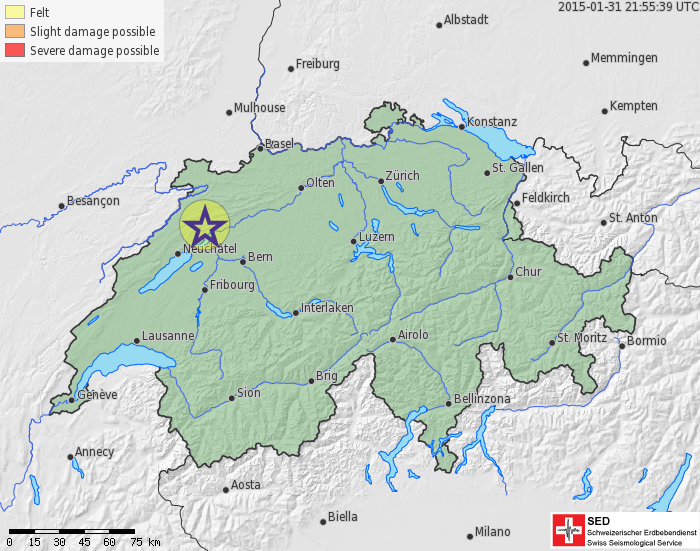
2015-01-31
Earthquake near Biel (BE)
Near Biel (BE), the Swiss Seismological Service registered an earthquake on January 31, 2015 at 22:54 (local time). The event had a magnitude of 3.1 and occurred at a depth of 9.6 km. Although the earthquake could be felt over a wide area no damage is expected.
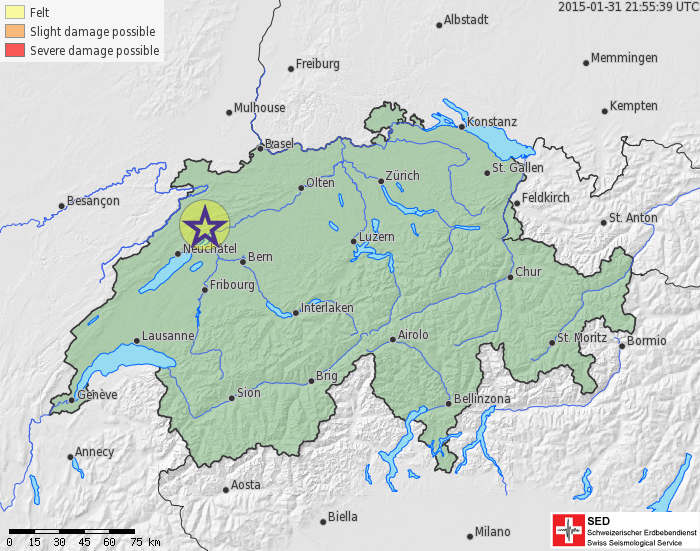
2015-01-27
Swiss Earthquakes in 2014: A Review
Compared to previous years, with around 950 earthquakes the number of recorded events is almost double (2013 about 600 earthquakes, 2012 about 500 earthquakes). This increase is mainly due to a lowering of the threshold for earthquake detection, the result of the densification of the seismic network over the past years. In addition, several earthquake sequences occurred in Switzerland in 2014, which contributed to the increased number of recorded earthquakes. For the earthquakes in 2014, the local magnitude (i.e. Richter scale) ranged between -0.4 and 3.2. The number of probably felt earthquakes with local magnitude of 2.5 and larger was 21, which is close to the yearly average number of 23 recorded over the last 39 years.
Read more...A remarkable earthquake sequence occurred at Diemtigen (BE), west of Lake Thun. Between April and December 2014 more than 260 earthquakes were recorded here, the three largest events occurred on May 10 (ML 2.7), June 25. (ML 2.7), and October 15. (ML 3.2).
In addition to the largest events of the Diemtigen sequence, the earthquakes in the region of Biel (January 8, ML 2.8 and 3.2), Volketswil (ZH) (November 8, ML 2.8), and Walenstadt (SG) (November 14, ML 3.1) were widely felt by the public. None of these earthquakes, however, was strong enough to cause damage.
In 2014, as in previous years, a large portion of the seismic activity was concentrated in the Valais and Graubünden. Other seismically active regions in 2014 were the area between Lake Walen and Liechtenstein, Central Switzerland, canton Fribourg, and the Swiss Jura.
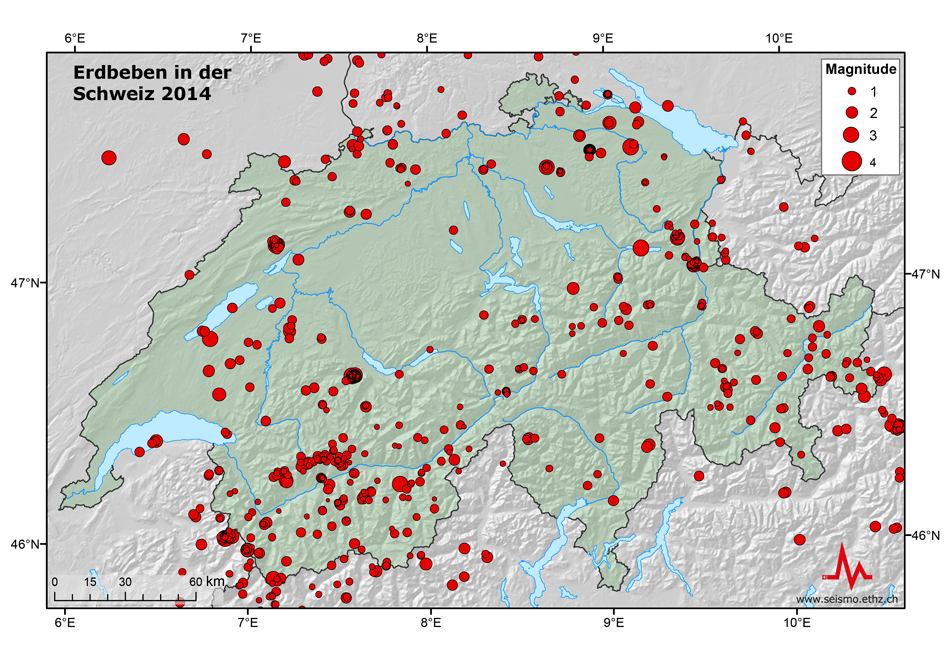
2015-01-25
Erdbeben bei Guarda (GR)
Am 25. Januar 2015 ereignete sich um 18:34 Uhr im Kanton Graubünden bei Guarda ein Erdbeben der Magnitude 3.0 in einer Tiefe von ca. 8 km. Das Erdbeben dürfte vereinzelt verspürt worden sein. Schäden sind bei einem Erdbeben dieser Stärke in der Regel nicht zu erwarten. Ein Nachbeben mit einer Magnitude von 2.3 ereignete sich um 18:38 Uhr.

2015-01-20
Your opinion is needed!
You are one of about 60,000 people per month who visit our website and therefore ideal to answer the following question: What do you like about our site or what are you missing? It does not matter if you are a first time visitor to our website or visit us regularly.
Your anonymous responses serve as a basis to optimize our website content and design. We are are thankful for five minutes of your time and are looking forward to the result!
